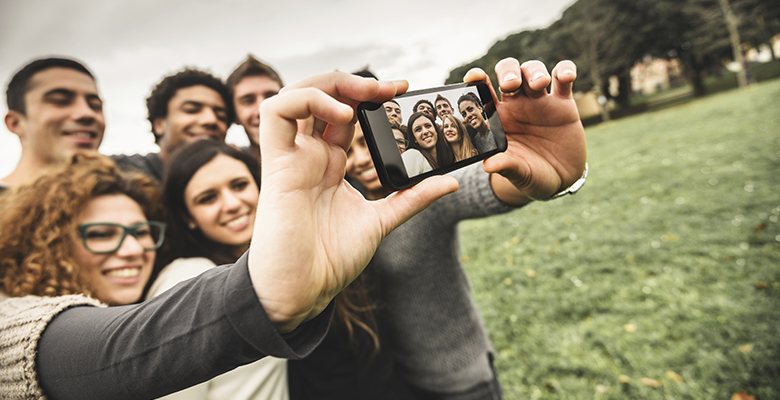
Whether we’re seeing new trending colors (millennial pink, anyone?), denim jean styles or even the ways consumers shop, we can all agree a lot has changed in the 21st century. One could recall the early 2000s, when “hanging at the mall” was all the rage.
Fast forward fifteen years and we now see an endless cycle of news around the continuing decline of big box retail, and the fact that the malls these brick-and-mortar stores anchor continue to see declines in traffic and sales. The likely culprit? The ubiquitous smartphone every millennial depends on – for everything from on-demand laundry services to snatching that new pair of sunnies in one fell swoop.
While the advent of social media and Instagram influencers can also take credit for the boom in online shopping, there is something more to these platforms that make the products they dangle in front of us so appealing. Whether certain items “catch your eye” in promoted posts or targeted ads – using mobile tactics and geo-location capabilities – brands are making it easier than ever to get from Point A of noticing the item to Point B of shamelessly surrendering your credit card to purchase it.
As the on-the-go millennial generation has shown us time and time again – convenience is key.
Another contributing factor to the rise in mobile shopping and a larger trend away from in-person retail is the fact that millennials put a premium on “experiences” and are spending more time outdoors. And more time outdoors does not mean scouring around an air-conditioned mall.
In fact, recent data shows consumers are spending more time than ever out and about in their communities. Whether that means rocking out at a music festival, getting a squad together to hike a local national park or simply wasting the afternoon away at a rooftop BBQ, the rest of the population can’t help but join in the contagious outdoor-loving spirit.
Millennials Heading Outdoors
In the same week headlines of a “retail apocalypse” were splashed across front pages nationwide, the Associated Press reported in a new survey that Millennials are driving a surge in spending time in the great outdoors.
“Millennials now account for 38 percent of the 75 million active camper households in the U.S., up from 34 percent in 2016, and 51 percent say they plan to increase their camping this year. Results of the survey indicate that these younger campers are using camping to add more balance to their lives,” states the AP report.
And it’s not just camping. A recent survey illustrated just how important music and outdoor festivals are to the millennial generation, who are sometimes willing to drop hundreds of dollars to avoid succumbing to the inevitable “fear of missing out.” From large-scale fests like Coachella to smaller local happenings like Outside Lands, it’s been proven that brands that sponsor such events are seen by 89% of surveyed millennials as more authentic and garner greater trust – positing that these consumers are more likely to welcome and purchase the brand in the future.
These real-life examples go to show that the generation most impacted by our mobile, on-demand world is responding by seeking more experiences outdoors. Even they realize that being a couch potato is not a long-term physical nor mental health strategy. And as a result, families across the country are following suit by embracing new activities that get them outside and engaged with one another.
The irony is that the same survey that showed millennials migrating to the great outdoors also noted that the most requested amenity at today’s campsites is… Wi-Fi. The same mobile technology that has changed the American experience may also liberate us in a way that lets us spend more time outdoors than in front of the television.
Advertisers Respond
It’s no secret that millennials spend more time on their smartphones than any other generation, and that many of their purchases are easily made online, at the tip of their fingertips. And advertisers are noticing.
If there’s one medium that has capitalized on the decline of the mall and the millennial generation’s love for the outdoors, it is out-of-home advertising. With consumers spending more time outside, exposed to a new wave of edgy and interactive digital billboards, brands are reconsidering how to get people shopping again.
Fashion brands with giant physical stores like Nike and online-only ASOS alike are beefing up their outdoor properties, from subway stations to wrapping buses to taking over whole building facades in major city centers. They may tweak a billboard’s mobile capabilities to send commuters a quick text with the nearest brick-and-mortar location or simply link to the online store or the particular item on display.
In their quest to meet millennials where they play, whether in the Meatpacking District or SOHO or the next “It” neighborhood, billboards have transformed from mere posters into inspirational canvases and metaphorical walls for online vendors – often more effectively evoking a certain feeling, lifestyle, or “vibe” the brand wants to put forth than a magazine ad can.
As a result, out-of-home ads have become the new playground for designers and artists, hired by brands to make their mark and define the new “cool” to their target audience – the multitude of passersby.
So, what lies ahead for advertising in our ever-evolving world? Adding mobile codes to billboards for real-time access to the product in front of us? The capability to take a picture for instant purchase? With the new wave of out-of-home advertising revolutionizing how shoppers interact with products today, and the way brands market them – the possibilities seem endless.
Originally posted to MarTech Advisor.
Download the PDF
Published: July 7, 2017